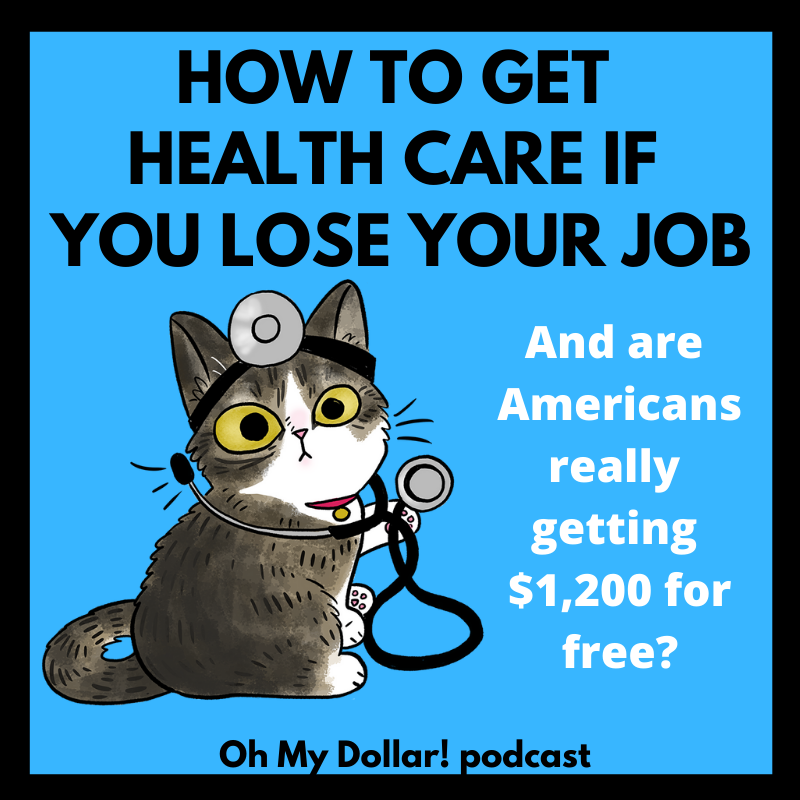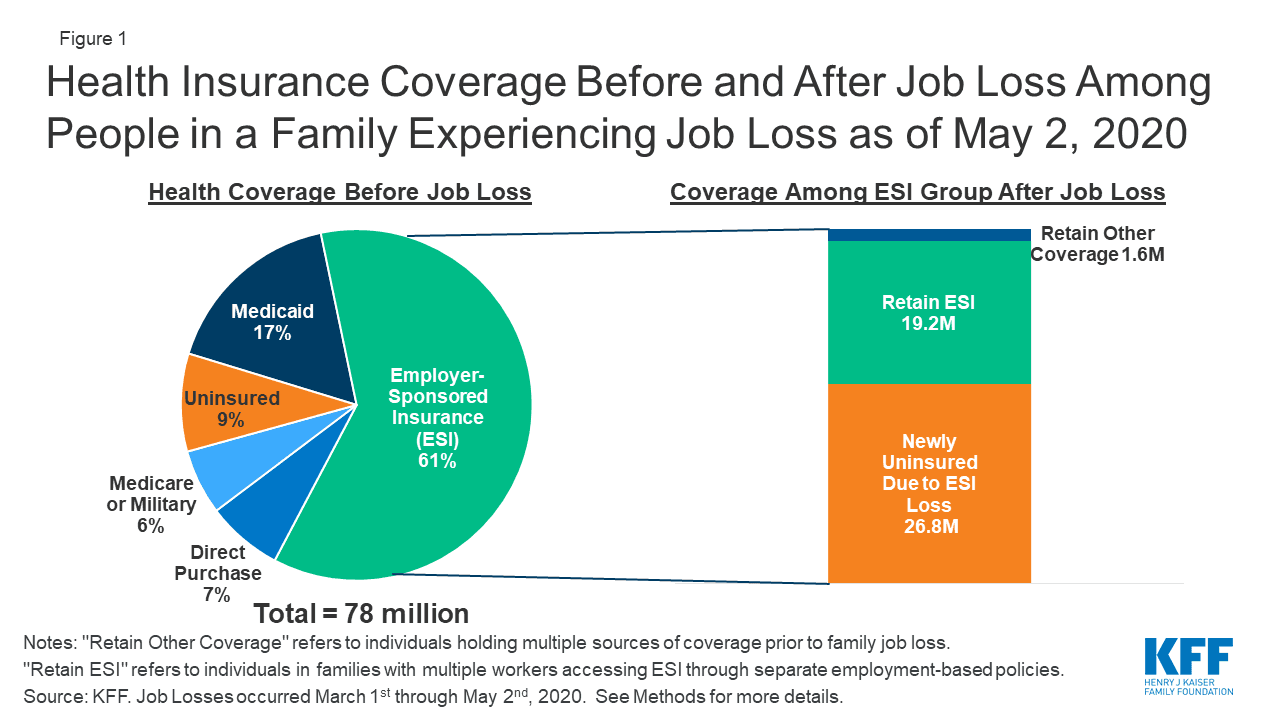After losing a job, you can get health insurance through COBRA or the Health Insurance Marketplace. Both options provide coverage continuity.
Losing a job can be stressful, especially when it comes to maintaining health insurance coverage. COBRA allows you to keep your employer-sponsored insurance for a limited time, though it can be expensive. Alternatively, the Health Insurance Marketplace offers various plans at different price points, potentially with subsidies based on your income.
It’s crucial to act quickly, as there are time limits for both COBRA and Marketplace enrollment. Researching and comparing your options will help you find the best plan to suit your needs and budget. Staying insured ensures you can access necessary healthcare without financial burden during this transitional period.

Credit: www.brookings.edu
Evaluate Your Current Coverage
After losing your job, it’s crucial to evaluate your current health insurance coverage. Understanding what your existing policy offers can help you make informed decisions. This section will guide you through the steps to review your policy details and understand grace periods.
Review Policy Details
Start by gathering all your insurance documents. Check the policy details to understand what is covered. Look for information on:
- Medical benefits: What types of medical services are covered?
- Prescription drugs: Are your medications included in the plan?
- Specialist visits: Do you need referrals to see a specialist?
- Emergency services: What emergency care is provided?
Use a table to organize important details:
| Coverage Type | Details |
|---|---|
| Medical Benefits | Check if doctor visits, surgeries, and lab tests are covered. |
| Prescription Drugs | Ensure your medications are included in the plan. |
| Specialist Visits | Find out if you need referrals for specialists. |
| Emergency Services | Review what emergency care is provided. |
Understand Grace Periods
After job loss, you might have a grace period to keep your insurance. A grace period gives you extra time before the policy ends. During this time, you can still use your insurance benefits.
Check your policy for the following:
- Grace period length: How many days do you have?
- Covered services: Are all services still covered during this time?
- Payment requirements: Do you need to pay any premiums?
Understanding these details ensures you use your coverage wisely. It also helps you transition smoothly to a new health insurance plan.

Credit: www.wellmark.com
Explore Cobra Options
Losing a job can be stressful, especially when it affects your health insurance. One way to keep your coverage is through COBRA. COBRA stands for the Consolidated Omnibus Budget Reconciliation Act. It allows you to continue your employer’s health insurance for a limited time. Let’s explore how COBRA can help you.
Eligibility Criteria
To qualify for COBRA, you must meet certain eligibility criteria. First, you must have been enrolled in your employer’s health plan when you were employed. Second, the health plan must still be active for other employees. Third, you must lose your job for reasons other than gross misconduct.
You also qualify if you are a dependent of a former employee. This includes spouses and children. The eligibility rules apply to all, regardless of your employment status.
Cost Implications
COBRA can be more expensive than your previous employer-sponsored plan. This is because you now pay the full premium. Your employer no longer helps cover the cost. The cost includes both the employee and employer portions, plus a 2% administrative fee.
For example, if your premium was $300 when you were employed, it could rise to $600 or more. This includes the full premium and the administrative fee. It is important to budget for this increase.
Here is a simple table to show the cost breakdown:
| Cost Component | Amount |
|---|---|
| Employee Portion | $150 |
| Employer Portion | $150 |
| Full Premium | $300 |
| Administrative Fee (2%) | $6 |
| Total COBRA Cost | $306 |
Understanding these costs helps you make an informed decision. COBRA can be a lifesaver, but it requires financial planning.
Consider Marketplace Plans
After losing a job, finding health insurance is crucial. One option is Marketplace plans. These plans are available through the Health Insurance Marketplace. This is an online service where you can compare and buy health insurance.
Open Enrollment Periods
The Open Enrollment Period is a specific time each year. During this time, you can sign up for a Marketplace plan. Usually, it runs from November to December. Missing this window means waiting for the next period. But, losing a job qualifies you for a Special Enrollment Period (SEP).
SEPs allow you to enroll outside the regular period. You have 60 days from the job loss to enroll. Act quickly to avoid a gap in coverage.
Subsidies And Discounts
The Marketplace offers subsidies and discounts to lower your costs. These are based on your income and household size. There are two main types:
- Premium Tax Credits: These lower your monthly premium.
- Cost-Sharing Reductions: These reduce out-of-pocket costs, like copayments and deductibles.
To see if you qualify, you need to provide income details. The Marketplace will calculate your eligibility for these savings.
| Income Level | Type of Subsidy | Benefit |
|---|---|---|
| 100%-400% of Federal Poverty Level | Premium Tax Credits | Lower monthly premiums |
| 100%-250% of Federal Poverty Level | Cost-Sharing Reductions | Lower out-of-pocket costs |
Review your options carefully. The Marketplace makes it easy to compare plans. Consider your health needs and budget. Choosing the right plan ensures you stay covered and protected.

Credit: www.ohmydollar.com
Look Into Medicaid
Losing your job can be stressful, especially without health insurance. One option is Medicaid. It’s a state and federal program. It provides health coverage for low-income individuals and families. Let’s explore how you can benefit from Medicaid.
Income Requirements
Medicaid has specific income requirements. These vary by state. Generally, you need to earn below a certain amount. This amount depends on the size of your household. For a single person, the limit may be lower. For a family of four, the limit will be higher.
| Household Size | Monthly Income Limit |
|---|---|
| 1 | $1,468 |
| 2 | $1,983 |
| 3 | $2,498 |
| 4 | $3,013 |
Check your state’s Medicaid website for exact income limits. These limits may change each year. Make sure you qualify before applying.
Application Process
The application process for Medicaid is straightforward. Follow these steps:
- Visit your state’s Medicaid website.
- Fill out the online application form.
- Provide necessary documents like ID and income proof.
- Submit the completed form.
After submission, you will get a response. This usually takes a few weeks. If approved, you will receive your Medicaid card. If denied, you can appeal the decision.
You can also apply in person. Visit your local Medicaid office. Bring all required documents with you. Staff will help you with the application.
For more details, call the Medicaid helpline. They can answer any questions. Ensure you understand your state’s specific process.
Check Spousal Or Parental Plans
After losing a job, you might feel stressed about health insurance. A quick solution is to check spousal or parental plans. These plans often offer good coverage and can be a lifesaver during transitional times.
Dependent Coverage
If your spouse has a job, they might have a health insurance plan. You can join their plan as a dependent. This is often the easiest way to get coverage quickly.
For young adults under 26, parental plans are an option. Parents can add their children to their existing health insurance plans. This is a great way to ensure you stay covered.
Enrollment Procedures
Before making any moves, understand the enrollment procedures. Each insurance plan has its own rules. Knowing these rules will help you avoid delays.
Here’s a simple table to guide you through the steps:
| Step | Action |
|---|---|
| 1 | Check if your spouse or parent’s plan allows dependents |
| 2 | Gather required documents (ID, proof of relationship) |
| 3 | Contact the HR department or insurance provider |
| 4 | Fill out and submit the enrollment form |
| 5 | Wait for confirmation and plan details |
Always check deadlines for enrollment. Missing these can delay your coverage. It’s crucial to act quickly and follow the steps carefully.
Being proactive will ensure you get the health coverage you need after losing a job. Spousal and parental plans are reliable options to consider.
Utilize Short-term Plans
Losing a job is stressful, especially if it means losing health insurance. Short-term plans can be a temporary solution during this time. These plans offer coverage for a limited period. They can help bridge the gap until you find new employment or secure other insurance options.
Coverage Limits
Short-term health insurance plans come with coverage limits. These plans are designed for temporary use, typically lasting from a few months to a year. They usually cover essential services like emergency care, hospital stays, and some doctor visits. However, they may not cover pre-existing conditions, prescription drugs, or preventive care.
It is crucial to read the fine print and understand what is covered. Check the plan’s maximum payout limits. This ensures you are not surprised by unexpected medical bills. Also, be aware of any exclusions or waiting periods that might apply.
Application Steps
Applying for short-term health insurance is straightforward. Follow these simple steps to get started:
- Research: Compare different short-term plans online.
- Choose a Plan: Select a plan that fits your needs and budget.
- Apply Online: Fill out the application form on the insurance provider’s website.
- Wait for Approval: Most applications are approved quickly, often within 24 hours.
- Start Coverage: Once approved, your coverage can start as soon as the next day.
Here is a simple comparison table to help you understand the features of short-term plans:
| Feature | Details |
|---|---|
| Duration | Up to 12 months |
| Coverage | Emergency care, hospital stays, some doctor visits |
| Exclusions | Pre-existing conditions, prescription drugs, preventive care |
| Approval Time | Usually within 24 hours |
Short-term plans are a viable option for temporary coverage. They can offer peace of mind during a job transition. Make sure to understand the coverage limits and follow the application steps carefully.
Frequently Asked Questions
What Are My Health Insurance Options?
You can consider COBRA, ACA marketplace plans, Medicaid, or short-term health plans.
How Does Cobra Insurance Work?
COBRA lets you keep your employer’s insurance for up to 18 months, but you pay the full premium.
Can I Get Medicaid After Job Loss?
Yes, if you meet income requirements, you can apply for Medicaid for low-cost or free health coverage.
What Is The Aca Marketplace?
The ACA marketplace offers health insurance plans with possible subsidies based on your income and household size.
Are Short-term Health Plans A Good Option?
Short-term plans are less expensive but offer limited coverage. They are a temporary solution until you get a permanent plan.
Conclusion
Securing health insurance after losing a job is crucial. Explore options like COBRA, ACA marketplaces, and Medicaid. Compare plans, evaluate costs, and choose the best fit. Staying insured ensures access to necessary healthcare and peace of mind. Make informed decisions and protect your health during transitional periods.
